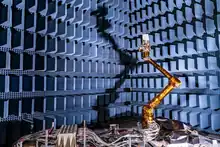DARPA’s Robotic Servicing of Geosynchronous Satellites (RSGS) program leverages commercial space technology to inspect and repair aging or broken satellites in the geosynchronous Earth orbit (GEO), about 35,786 kilometers (22,236 miles) from Earth.[1]

Background
According to DARPA, no options exist for visual diagnosis, upgrades, or repairs of a malfunctioning satellite's components, thus rendering these satellites space junk.[2] In 2020, DARPA selected Northrop Grumman's subsidiary SpaceLogistics as its RSGS partner. The U.S. Naval Research Laboratory designed and developed the RSGS robotic arm with DARPA funding. The robotic arm has completed key tests and is on track to be launched to GEO in 2024 by Northrop Grumman's 3000-kilogram spacecraft. The DARPA robotic mechanic is anticipated to start making on-orbit service calls in space in 2025.[2][3]
References
- ↑ "DARPA's robot could start servicing satellites in 2025". spacenews.com. November 8, 2022. Retrieved May 31, 2023.
- 1 2 "DARPA's Robotic In-Space Mechanic Aces Tests, on Track for Launch". darpa.mil. November 8, 2023. Retrieved May 31, 2023.
- ↑ "US DARPA completes component-level tests for RSGS programme". airforce-technology.com. November 9, 2022. Retrieved May 31, 2023.